Why are mutual engagement plans important?
Mutual engagement plans, particularly CS-led mutual engagement plans can be very impactful when it comes to moving the needle forward and creating lasting partnerships with you and your customers.
Building consensus
Your customers do not always necessarily know how to engage with you. We live in a world and work in an industry where our products and services are becoming increasingly complex.
As such, the ways in which we need to engage with our customers have to evolve as well. As CS leaders we need to set the tone for how our customers will engage with us and be more consultative in our approach, otherwise, our customers will have a less positive experience with our products and services.
This is why it's important we build this consensus with our customers upfront and in a concrete way.
Aligning on outcomes
As I mentioned earlier, my wife and I had very different plans for how we wanted our trip to go because we had not aligned on outcomes. My KPI was how many things we could do or see, and her KPI was relaxation.
Similarly, mutual engagement plans help you align on outcomes with your customers. Without aligning on outcomes, your engagements with your customers can feel a little bit aimless and reactionary.
Conversely, when you align on outcomes and determine the best next steps, it allows you as a CS leader to be more proactive, and add a sense of direction to your engagements.
This also allows you to build trust with your customers because it lets them know you also have skin in the game and future discussions and solutions will be centered around their success.
Put the partnership in perspective
One of my favorite things to do on vacations is take photos, mainly because it's always nice to look back and relive some of those memories.
Similarly, mutual engagement plans allow you to take a snapshot of the engagement, they give you shared ownership when it comes to the customer's experience and they allow you to look back and say look at all the amazing things we were able to accomplish together.
I know for a lot of CS folks, it can sometimes feel difficult to quantify the value you've delivered to your customers. However, with mutual engagement plans, you have concrete and quantifiable evidence of all the work you and your stakeholders have been able to accomplish.
This allows you to build even more trust and build stronger partnerships with your external stakeholders.
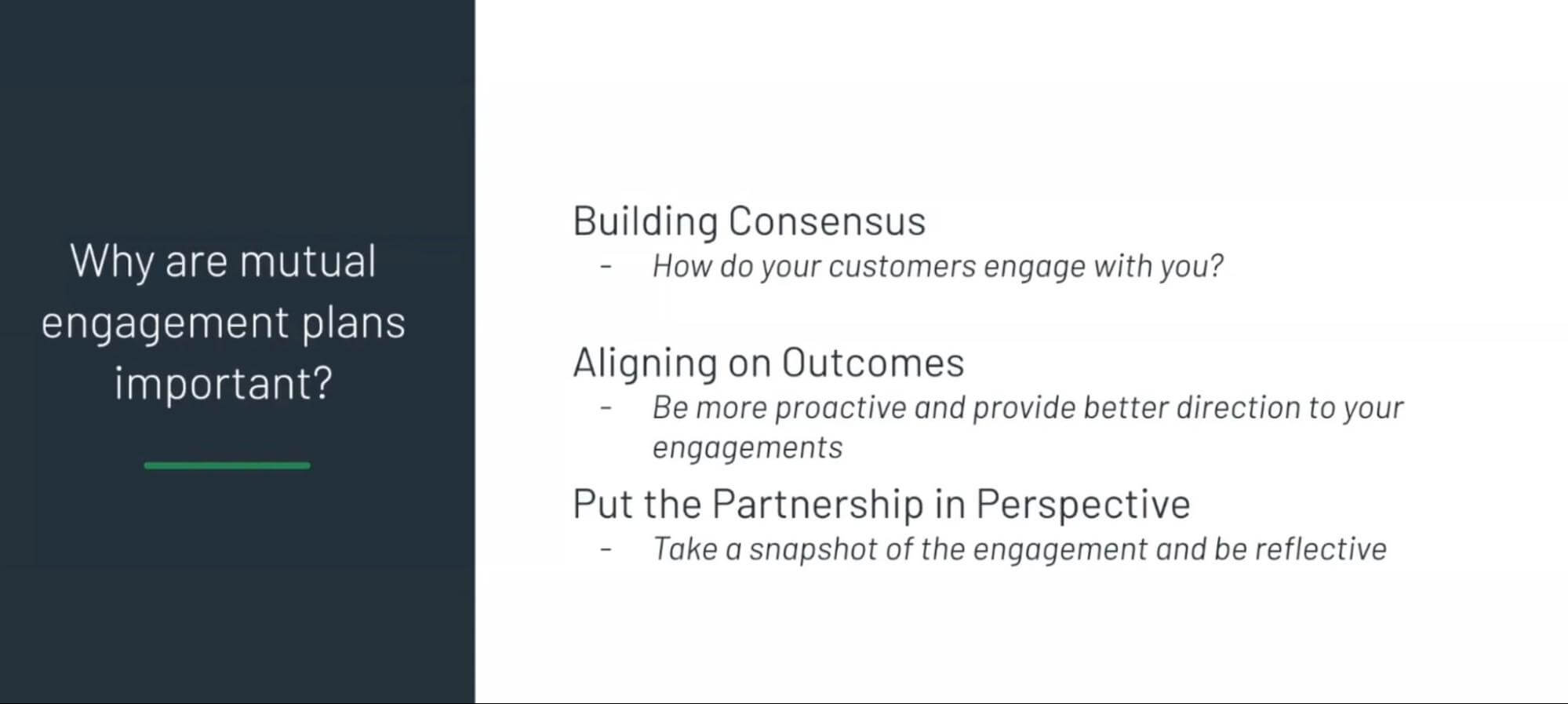
How to successfully position and conduct a mutual engagement plan
Positioning
I talked a little bit about why mutual engagement plans are important, but next, I'll talk about how to position them.
Set the tone for the engagement
As I mentioned earlier, one of the key pieces of a mutual engagement plan is setting the tone for the engagement. Let's look at this through the customer's lens.
- In some cases, they do not necessarily know who you are.
- In some cases, they may not know what customer success is or what it looks like at your company.
- They may not know how to leverage your products or services, and most importantly,
- They may not know how to engage with you specifically.
This is why it is so important you give a proper introduction and make sure the customer knows exactly who you are and how you plan on helping them achieve their goals.
- Explain in detail what customer success looks like at your company.
- Identify any potential gaps in understanding the customer might have when it comes to leveraging your products and services. And
- Let them know in detail how they can expect to engage with you specifically.
Position the engagement plan strategically
As far as when I typically like to position mutual engagement plans, I typically like to do it either during onboarding or an EBR or QBR. For me, this seems like the most logical time mainly because you're looking at the account and your partnership a little bit more holistically.
Get the customer’s buy-in
It's also easier to get buy-in from the customer because they're in a more forward-looking headspace during these types of calls. And it's a lot easier to determine whether or not customers even agree that the engagement plan may be more beneficial via call or in-person than it is via email.
I'll caveat this by saying there's no perfect time to engage your customers with an engagement plan. Really, the sooner the better and more proactive you can be.
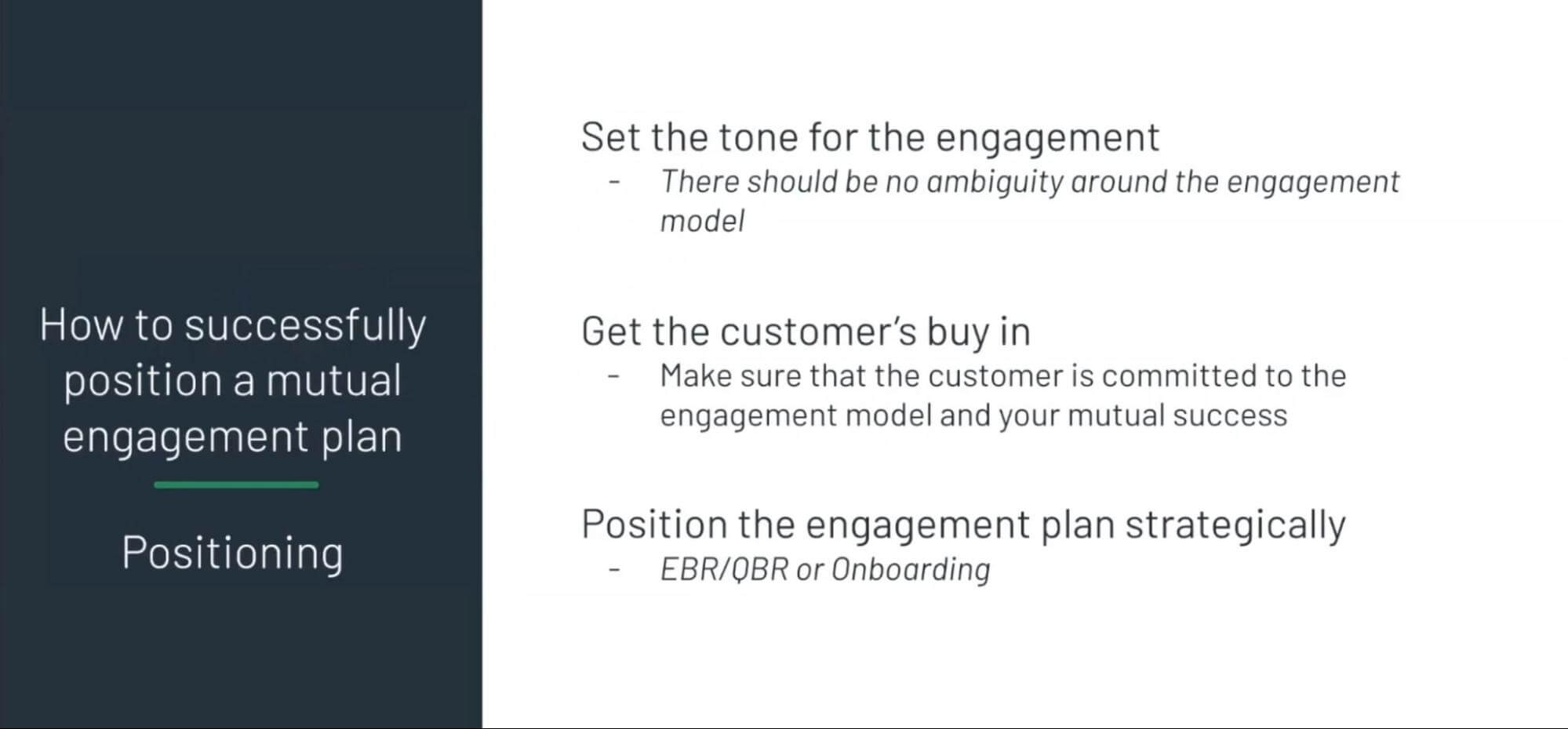
Milestones
Identify key milestones
Another key piece of positioning your mutual engagement plan is identifying and agreeing on the key milestones for your engagement. For example, if this were a vacation:
- When are you booking your flights?
- When are you flying?
- Where are you flying out of?
- What time should we leave for the airport?
Determine your cadence to achieve your goals
This will inform the cadence of your engagement, the levers you may need to pull on your end to ensure the customer's success and hold you and your customer accountable to an agreed-upon timeline with clearly defined goals.
This makes it easier for you to say something like "As we agreed to during our onboarding session we'll catch up again in June to gauge your progress on XYZ. To help you complete XYZ, I suggest we have a workshop in July to help answer any questions that you or your team might have".
Manage customer expectations
Statements like this add more direction to your engagement, help you better manage customer expectations, and allow you to be more proactive when it comes to your customer's success.
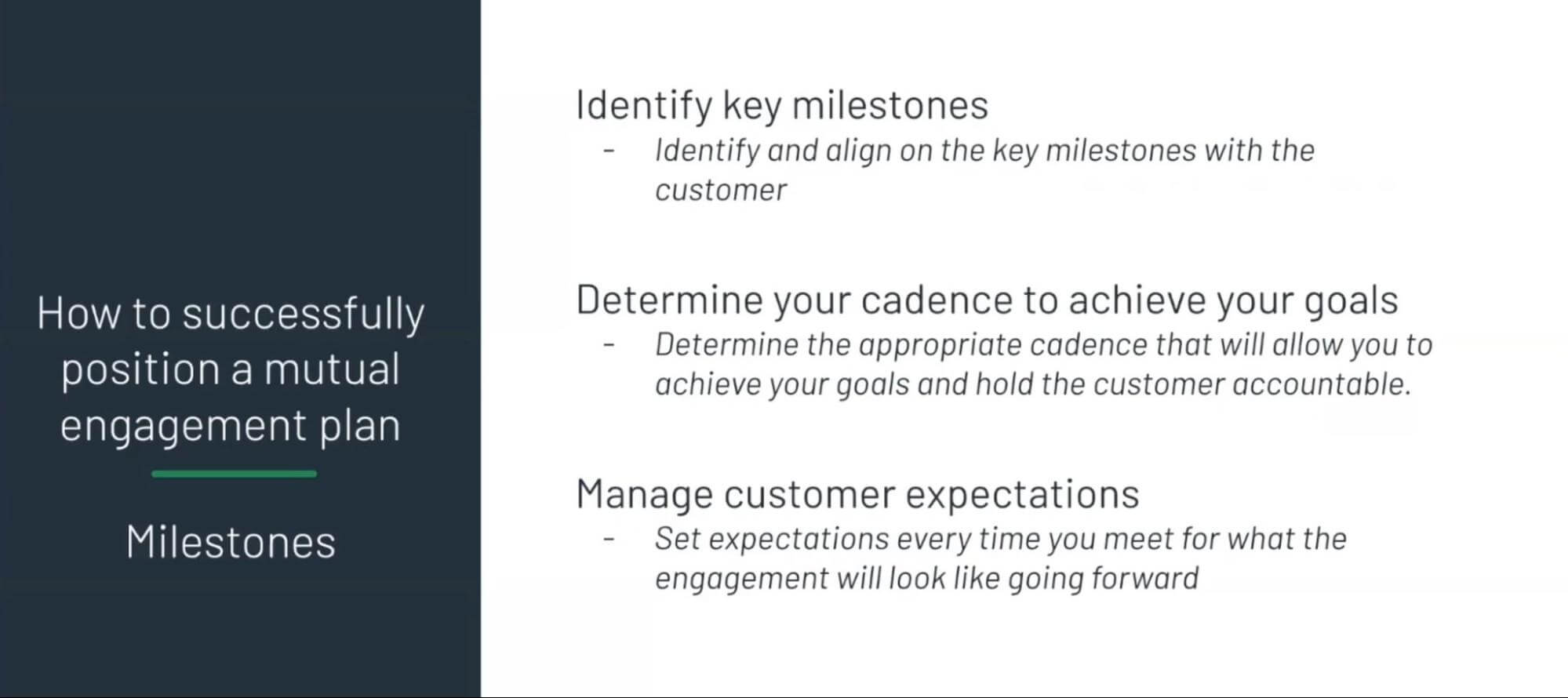
Be prescriptive
Next, I want to talk a little bit about being prescriptive. This one can be a little bit challenging, particularly for newer CSMs or when you're just getting started in a new company. However, it's important to consider a few things that may help give you the confidence you need to do this effectively.
You are an expert
You are an expert in engaging with your customers. Whether your customers know it or not your customers are looking to you for expertise on how to engage with your company. As I mentioned earlier, no one has more insight on how to engage with your customers than you as their dedicated CSM does.
You have a diverse book of business
You have a diverse book of business with varying challenges, you have deep knowledge of your products and services, and you are knowledgeable when it comes to common customer pain points.
All of this knowledge allows you to be prescriptive and consultative when it comes to suggesting your products and services and helps position you as a valuable resource and trusted advisor.
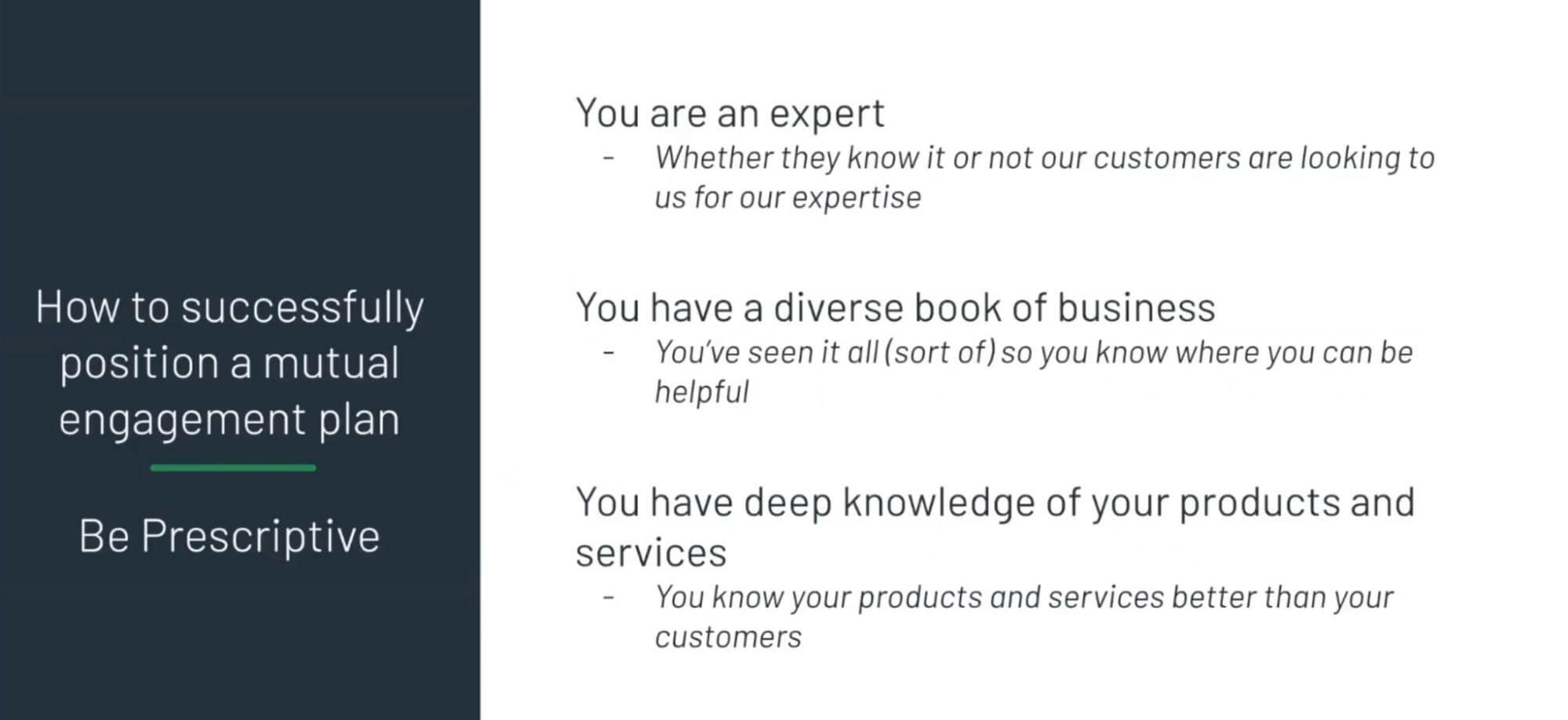
Practical example
I thought it would be helpful if we were to better visualize exactly what I'm describing. I went ahead and create a practical example of what a mutual engagement plan might look like.
Let's talk about the engagement plan for the Bluth Frozen Banana stand.
Current state/future state
The first thing we're going to want to do is to talk about the current state and future state of the engagement and determine which teams need to be a part of the process to get us from point A to point B.
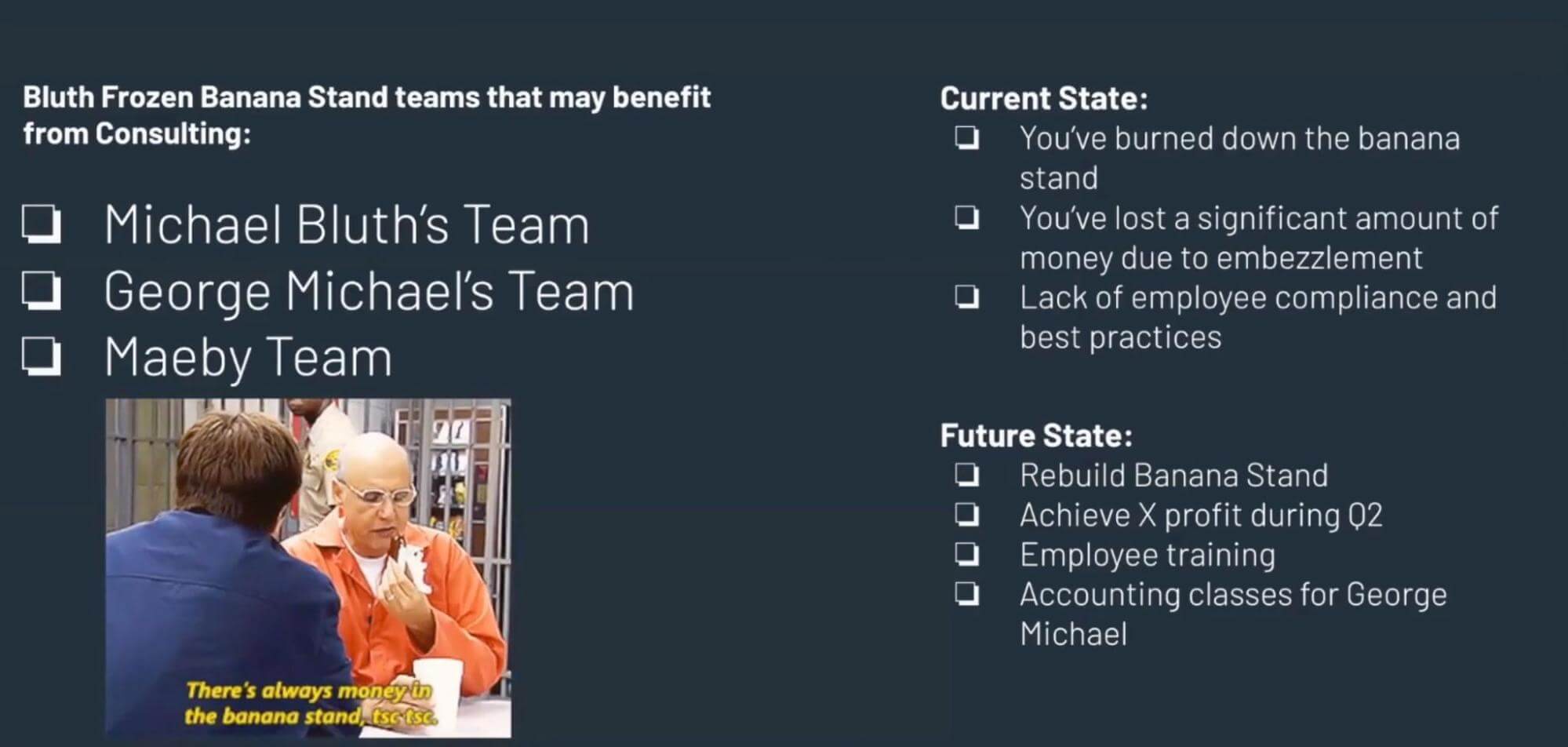
You'll see here we have all the teams we believe should be involved in the engagement plan. We have Michael Bluth's team, we have George Michael's team, and then we have Maeby’s team.
Current state
Then we have the current state of the business where the banana set has been burned down and there's a serious lack of oversight when it comes to employee compliance.
Again, the banana stand has been burned to the ground, you've lost a significant amount of money due to loose morals and bad math on Michael and Maeby's part and there do not seem to be very solid best practices internally at the banana stand.
Future state
Then we have the future state where we are looking to rebuild, become profitable, and get our employees the training they so desperately need.
Product/service options
Next, I'll typically talk about the products or services we believe will help the customer.
In this example, these are products and services that have already been purchased so we're not necessarily selling them on the product, but simply reminding the customer of all the products that exist and how their team might be able to leverage them.
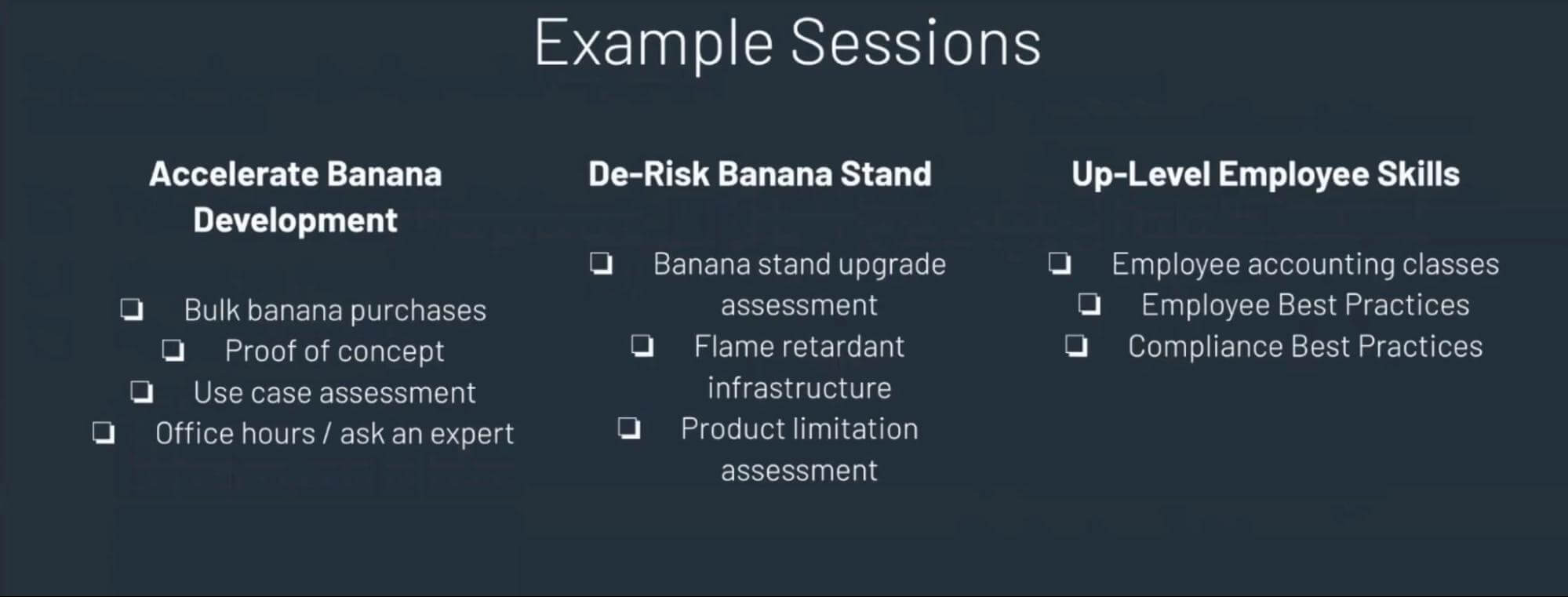
You'll see here we have a number of ways we can align with the customer whether it be on banana development, de-risking the banana stand, or simply employee training.
Then we have a number of example sessions the customer can choose from, like bulk banana purchases, banana stand upgrades, or employee accounting classes.
Suggestions
There I'll typically add suggestions.
Remember: be consultative
Remember, this is your opportunity to be a little bit more consultative. You know your customers incredibly well so do not be afraid to be prescriptive when it comes to different ways your products and services can help your customer be successful.
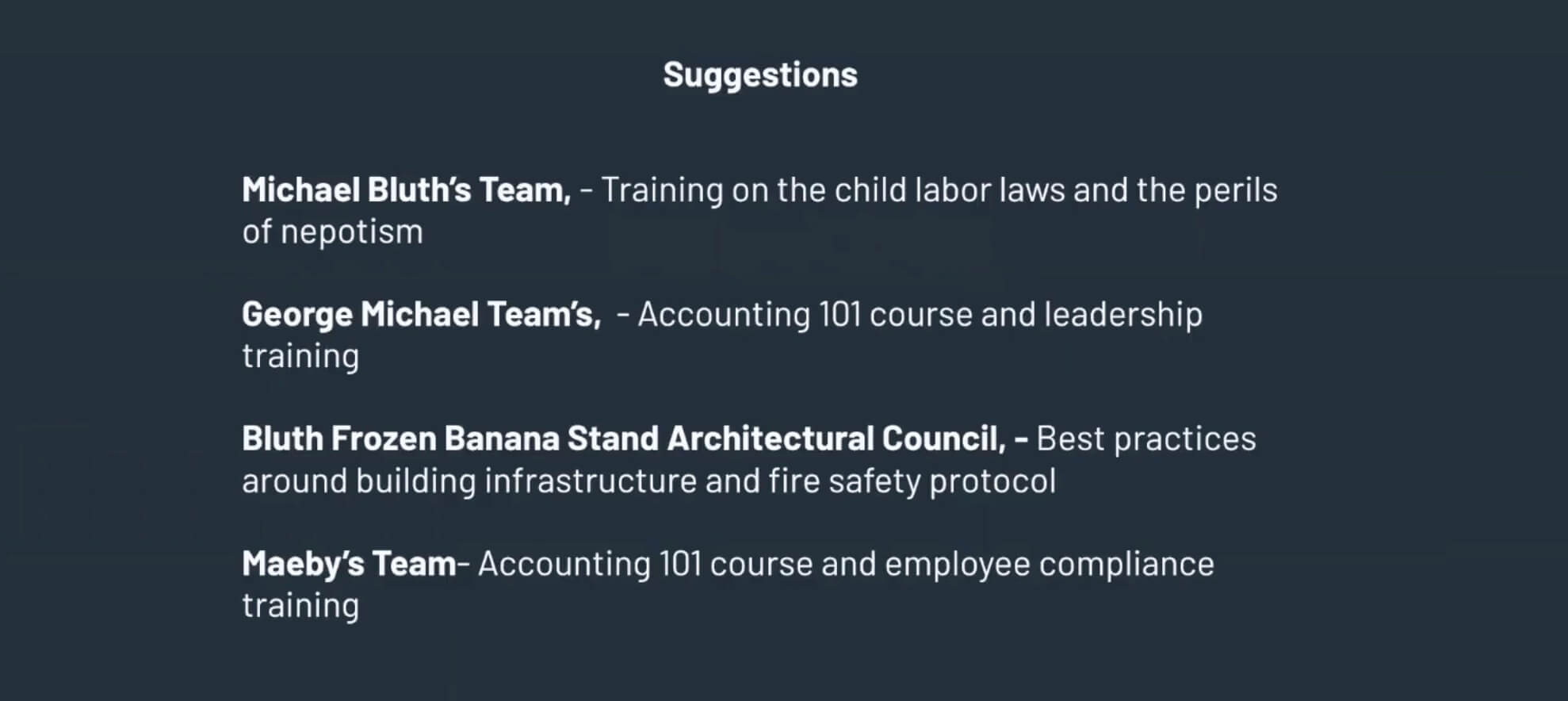
You'll notice here we've taken some of the potential sessions from the previous image and laid them out for the customer in a way that is a little bit more digestible. Doing so allows the customer to filter out potentially unnecessary information and make a more informed decision.
This way, if George Michael's team, for example, is curious about the best way to avoid making similar accounting mistakes in the future, we can point them directly to the accounting 101 courses.
Milestones
Lastly, I'll typically take the customer through the suggested milestones. This is the real meat of the engagement plan. This is where you are able to gain the customer’s buy-in and hold the customer accountable to clearly defined cadences with clearly defined action items.
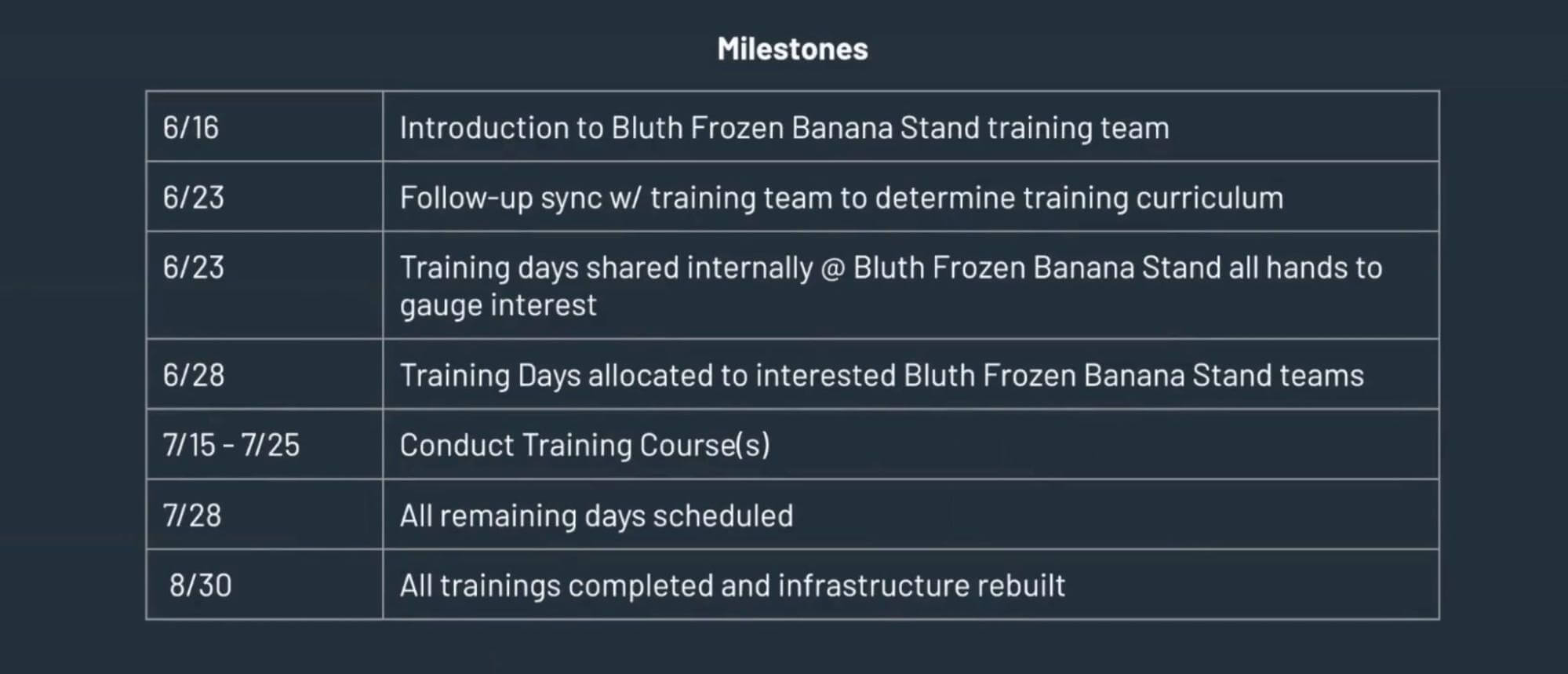
Assuming the engagement plan is successful this can serve as your artifact or a timeline to showcase everything you've been able to accomplish with the customer.
Our engagement plans need to evolve
As I mentioned earlier, the complexity of our engagements has continued to evolve over time so it stands to reason our engagement plans will also need to evolve. While this example is satirical, I hope it gives you a better understanding of how you may eventually want to construct your own engagement plans, if you're not doing so already.
One quick tactical thing to point out, I'll typically send this slide deck out to our customers following our call once we've outlined the mutual engagement plan.
Customer success-led mutual engagement plans
I've talked a little bit about how you may want to leverage mutual engagement plans with some of your customers but next, I want to talk a little bit about why it's important that these engagements be led by customer success.
Why CS-led?
Varying roles
CS is not sales and sales is not CS. There are some instances where the two roles may overlap. But ultimately, it's important both you and your customers understand the difference between the two roles.
Your sales team's job is to sell customers on the dream of all the amazing things they'll be able to do once they purchase your company's products and services. Your job as a customer success manager is to turn that dream into reality.
Consequences of mismatched expectations
When those dreams are not achieved, or these expectations are not met, this can inevitably lead to turn. Some of the top reasons for churn are poor onboarding, lack of ongoing support, and lack of engagement or confusing engagement models.
How mutual engagement plans can help you avoid these issues
Mutual engagement plans are an all-encompassing way of potentially avoiding all of these scenarios, while simultaneously building your own relationship with your customers.

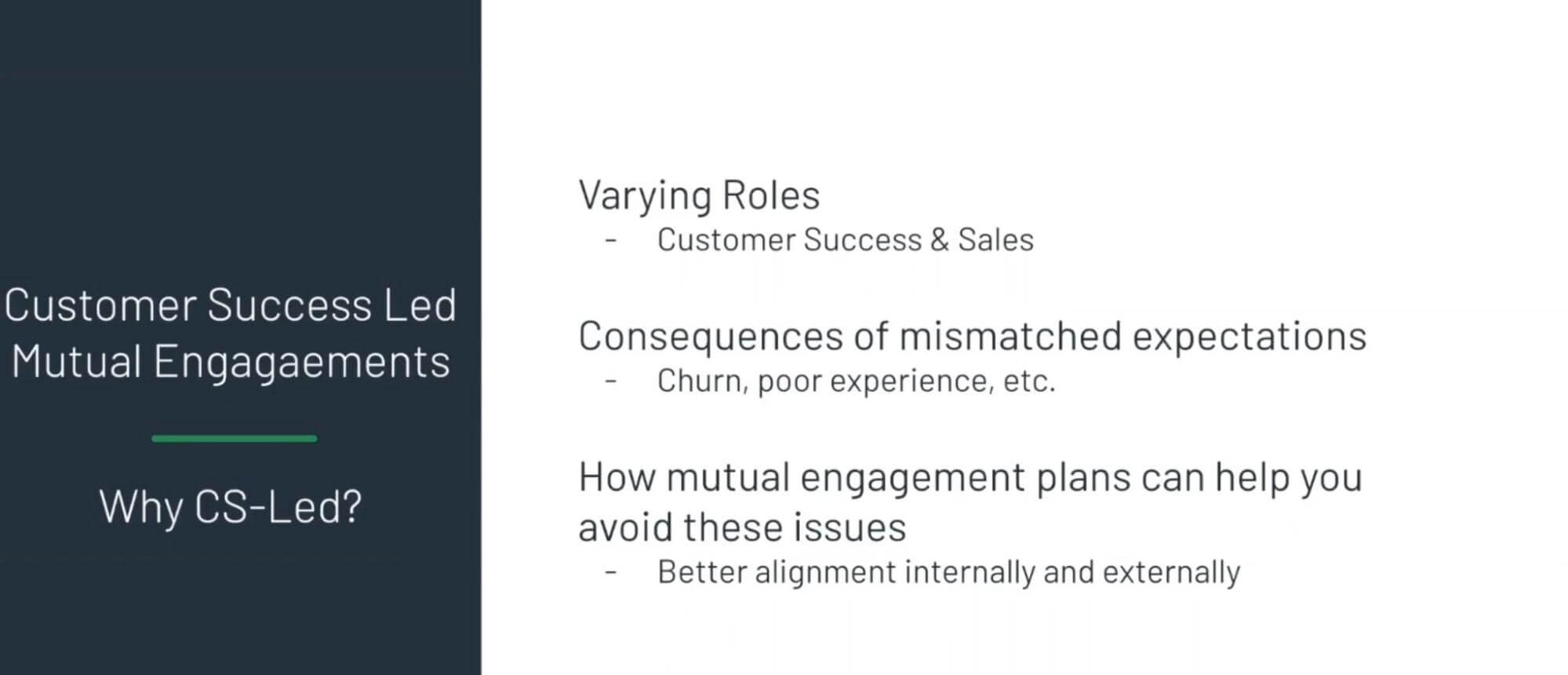
Owning the relationship
Depending on where you work, the sales cycle can be several months long, even years long, for a particular customer opportunity. As a result of this, the customer can develop a level of attachment to a particular sales rep, and become accustomed to going to that person whatever issues may arise.
Potential consequences of not forming your own relationship with the customer
This can be problematic for a number of reasons.
- It makes it difficult to build your own relationship with your customers.
- It could lead to poor customer experiences where the customer feels like they're being sold to whenever they reach out to solve a problem.
- It keeps the salesperson from other valuable work they could be doing, like pipeline generation or new business meetings. And
- It creates a potentially confusing engagement model where the customer is unsure of who to reach out to and when.
The first point I mentioned, where it makes it difficult to build your own relationship and creates a poor customer experience is probably the most important one and the one I'd like to highlight.
The two hotels analogy
A CS leader I've worked with in the past shared this really pointed analogy that has really stuck with me over the years. She said, "Let's take two hotels".
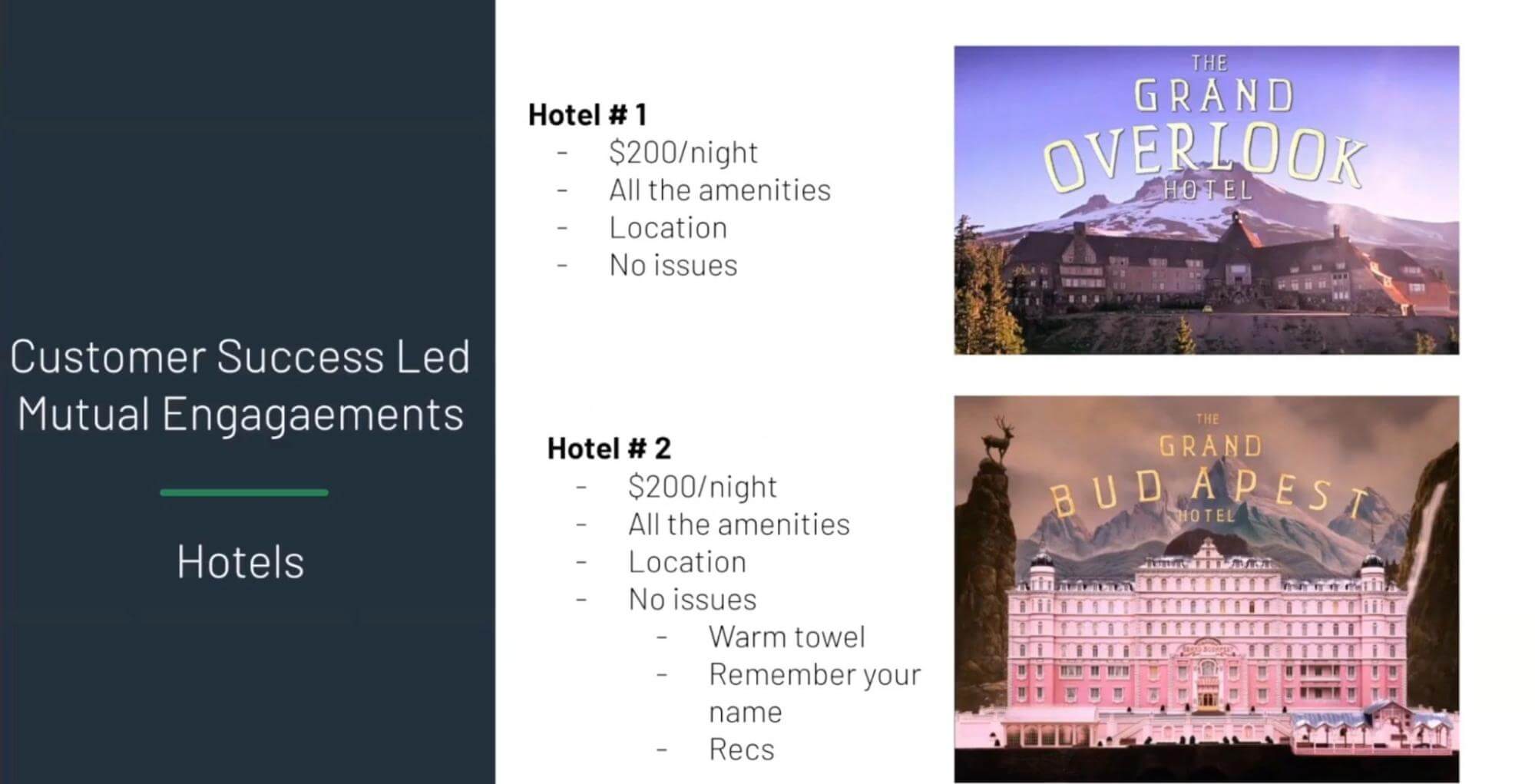
In this example, we have the Grand Overlook Hotel from The Shining and then we have The Grand Budapest Hotel.
- One hotel is $200 a night, it has everything you're looking for, it's in the right location and there aren't really any issues with that hotel throughout your stay.
- There is another hotel that is also $200 a night, it also has everything you're looking for and it's also in the right location, but they also give you a warm towel every morning, remember your name whenever you check in or check out, and give you great recommendations on what to do during your stay.
Keeping all these things in mind, which hotel are you going to stay at more often?
Nine times out of 10 it's going to be that second hotel. This is one of the reasons why it is so important that CS form their own relationships with their customers.
Because similar to this example I just laid out, the customer's experience is going to be marked by their interactions with customer success, and the customer's experience with your products and services is going to be a key factor when it comes to keeping your customers coming back.
Swim lanes
Potential tension
One thing that can come up as you embark on a CS-led engagement plan is a bit of tension between sales and CS. This is completely natural. As I mentioned earlier, in some cases, the sales team may have been working with this account for years so sharing some of that ownership can be challenging at first.
One key thing to anchor to though is the fact the customer comes first. Regardless of your individual goals or preferences or how you would like to engage with the customer, the customer's needs and experience always needs to be at the center of the conversation.
Internal and external
This is why mutual engagement plans can be as valuable internally as they are external. What do I mean by that?
How mutual engagements plans can help you avoid these issues
Mutual engagement plans allow for more clearly defined swimlanes internally for you and your sales counterpart by differentiating the work you're doing and the outcomes you're hoping to achieve.
This makes all the guesswork super easy and completely takes it out of the equation. Your customer's experience will be directly impacted by the relationships between you and your sales counterpart.
So it's important you collaborate with one another and engage with the customer in a thoughtful way.
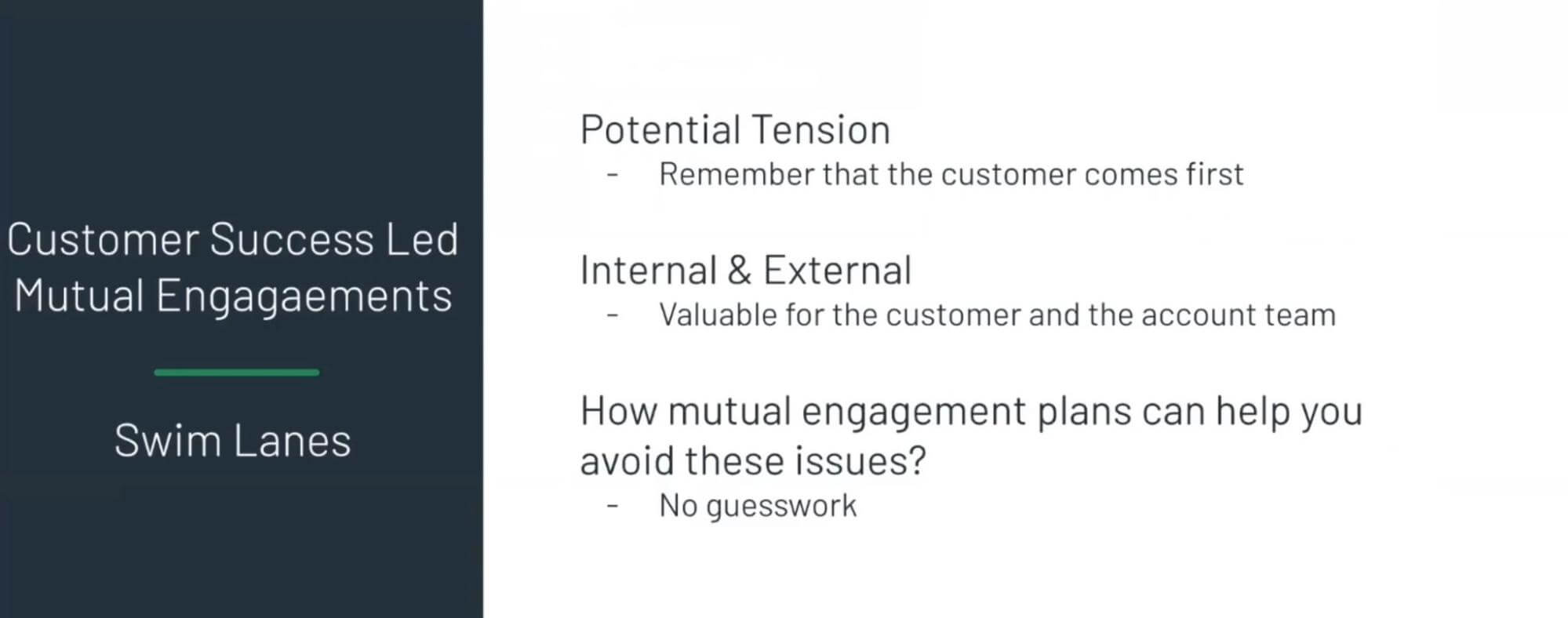
Summary
Mutual engagement plans are like a travel itinerary
Mutual engagement plans are a lot like a travel itinerary and similarly to a travel itinerary, they can have a profound impact on your and your customer's experience.
They can be important for a number of reasons such as building consensus, aligning on outcomes, and putting your partnerships in perspective.
Position the plan strategically
It's important to remember that the way the plan is positioned is just as important as creating the plan itself. To do this successfully, you'll need to set the tone for the engagement, get the customer’s buy-in, and be strategic in positioning the engagement.
Milestones should be clear, actionable, and consultative
Additionally, you'll need to ensure the milestones set out in your engagement plans are clear, actionable, and consultative. Doing so will help keep both you and your customers accountable, and position you as their trusted advisor.
CS-led mutual engagement plans help you drive customer engagements
Lastly, it's important to remember that CS-led mutual engagement plans can help you and your sales team in a number of ways, whether it be by mitigating churn, building stronger relationships with your customers, creating a better customer experience, or just more well-defined swimlanes for you and your sales counterparts.
Mutual engagement plans can act as a guide for your customers' relationships, both internally and externally.
I'll caveat this by saying if this is not something that is already in your tool belt, it can be challenging to develop this muscle. But like anything else, once you've had success with it, it will become easier and easier to repeat that success.



 Follow us on LinkedIn
Follow us on LinkedIn



